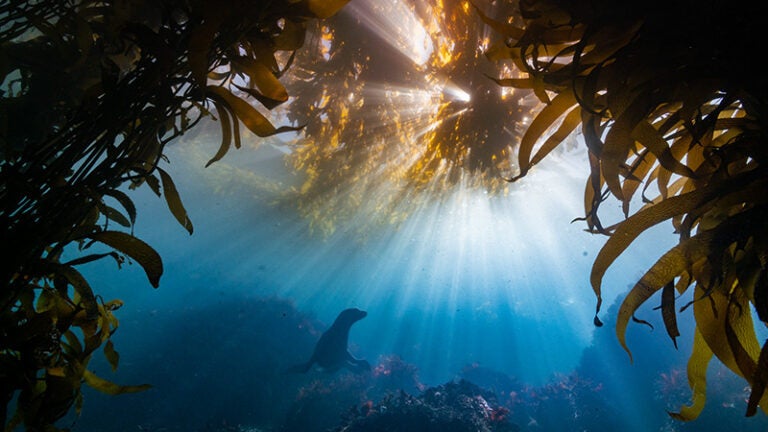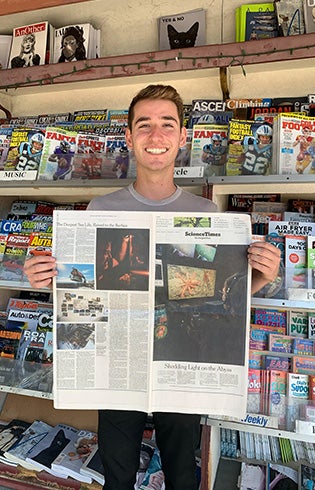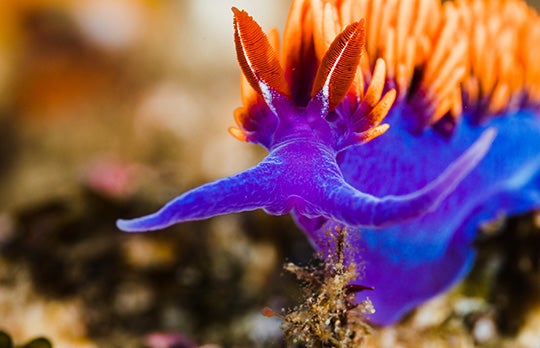
Alumnus travels the world documenting life’s splendor
Rousing himself from his temporary sleeping quarters on the floor of his friend’s Monterey, California, home, Tyler Schiffman puts on his wetsuit, packs up his camera and diving equipment and heads to the ocean.
After lugging 70 pounds of camera and diving equipment across the empty early morning beach and swimming out through the chilly waters to a kelp bed, he checks his air supply and defogs his mask, then dives.

Heading a few feet down, he carefully composes an image of the sunlight at the surface filtering through a patch of kelp, and just as he presses the shutter button, a seal enters the frame.
“The seal swam in, paused for half a second, and swam out. Later that night, reviewing my photos, I thought, ‘Oh my god, this is a really special photo,’” Schiffman says.
A conservation photographer and filmmaker who graduated from the USC Dornsife College of Letters, Arts and Sciences in 2017, Schiffman has spent much of the past four years underwater (and sometimes out of it), shooting up-close photos of animals around the world for publications such as The New York Times, The Atlantic and Nature Conservancy Magazine.
“My goal is to raise awareness of conservation and humanitarian work,” Schiffman says. “A lot of these amazing stories are just sitting there happening, which is great. But getting the word out to the public raises awareness, raises money for these nongovernmental organizations and can make a big difference in the world.”
Getting into the water
Growing up in Southern California, Schiffman spent a lot of time in the ocean.
“I was just a little beach bum kid growing up, free diving, surfing and spear fishing as much as possible. It really made me think, ‘Wow, this world is amazing. I want to protect this,’” he says.
At USC Dornsife, Schiffman majored in environmental science and health. His introduction to underwater photography came through the USC Dornsife Environmental Studies program, where he took “Introduction to Scientific Diving” (ENST 298) with David Ginsburg, professor (teaching) of environmental studies. Through this course, students are trained and certified as scientific divers at the USC Wrigley Marine Science Center on Santa Catalina Island, off the coast of Los Angeles.

“Tyler has an amazing eye. He would take his camera out every time we went out into the field and shot photos, practicing and getting better,” Ginsburg says. “It’s easy to take pictures, but it’s hard to really capture images well.”
It was during Ginsburg’s “Problems Without Passports: Integrated Ecosystem Management” summer course (ENST 480) in Palau during his junior year that Schiffman met an acquaintance of Ginsburg’s who had done some work for National Geographic. After the class ended, Schiffman stayed in Palau for a few more weeks learning more about photography, and he started to think about making it more than a hobby.
Back at USC, he picked up a minor in cinematic arts to gain more technical proficiency, and after graduation, he started out small, submitting pictures to local magazines in Los Angeles and then to international photo competitions.
At that time, he was interested in documenting life in the ocean, especially the small, delicate animals few people ever see.
“This is the life that could disappear in half a second. You kick a coral with your fin and it dies. A little change in temperature, a little change in salinity or pH and these lives are gone,” he explains. “With these photos you’re not going to go and tell some type of groundbreaking news about the macro life of the ocean — it’s more just to show people that it exists.”
Greater recognition

With help from a USC friend, one of Schiffman’s photos ended up in an Atlantic article about giraffes. Another image made the cover of The New York Times’ Science section. It was then, Schiffman says, that he started to shift his focus from natural history photography to photojournalism and documentary filmmaking.
“I thought, now that I have my photography skills refined, let’s get my story skills refined,” he says.
Schiffman currently has several film and photography projects in development. One is a documentary about a small town in Mexico in which nongovernmental organizations and a construction technology company are using 3D printing technology to create houses for the impoverished residents. Another documentary, recently completed and ready for the film festival circuit, looks at the life of a sea urchin diver. He continues his conservation photography and commercial work, as well.
“Other photographers have said, ‘It’s not the photos you take, it’s the stories you tell.’ I have found what I love: It’s being a storyteller,” he says. “It’s taking these scientific stories, my love of science and my love of the ocean and communicating it to people.”